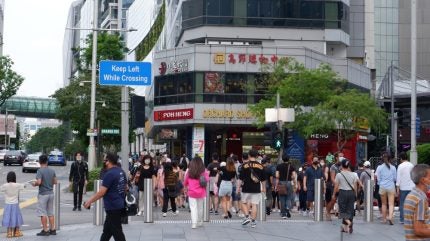
The retail market in Singapore is experiencing renewed vigour as a surge in international visitor numbers boosts demand for prime shopping space.
With the island welcoming around 12.9 million overseas arrivals by the end of the third quarter of 2025, the retail property sector has seen rising rents and robust occupancy in key districts.

Discover B2B Marketing That Performs
Combine business intelligence and editorial excellence to reach engaged professionals across 36 leading media platforms.
High-footfall corridors such as Orchard Road and Scotts Rroad are particularly benefiting from the influx of tourists.
Tourism recovery anchors retail resilience
The steady rebound in tourism is acting as a stabilising force for the retail industry in Singapore.
By the end of Q3 2025, the nation had welcomed approximately 12.9 million international visitors, a marked recovery from pandemic-era lows. Island-wide retail occupancy was recorded at 93.1% in Q3.
The outlook for full-year 2025 remains bullish, with forecasts placing international visitor arrivals in the range of 17 to 18.5 million and tourism receipts projected at S$29 billion to S$30.5 billion.

US Tariffs are shifting - will you react or anticipate?
Don’t let policy changes catch you off guard. Stay proactive with real-time data and expert analysis.
By GlobalDataThese developments suggest that rising tourist footfall is translating into stronger foot traffic for retail destinations, thereby underpinning confidence among landlords and retailers.
Rent growth in prime retail zones
In key shopping belts such as Orchard Road and Scotts Road, the spill-over from tourism is evident in rental trends. First-storey prime retail rents in these zones increased by about 0.5% quarter-on-quarter to S$41.80 per square foot during Q3.
While the growth is modest, it indicates that retailers are willing to maintain visibility in high-traffic locations where tourist volumes remain elevated.
Leasing activity in Q3 was driven less by new market entrants and more by relocations and space-optimisation among incumbents seeking to make the most of incoming shoppers.
The tightness in occupancy and upward pressure on rents signal that the recovery in Singapore’s retail leasing market is largely tourism-led.
Implications for shoppers and retailers
For international visitors and local consumers alike, the uptick in tourism and retail demand translates into a richer shopping environment—with more luxury brands, new store openings and improved offerings in central shopping districts.
However, the heightened demand for retail real estate may lead to cost pressures for retailers, which could influence pricing or promotional strategies.
Retailers operating in tourism-dependent locations will need to optimise their store layouts, curate their product mix and enhance the shopping experience to meet the expectations of international shoppers.
On the landlord side, the sustained interest in prime space reinforces the value of strategic retail assets in Singapore’s central districts.
While the broader retail market still faces challenges from rising operating costs and changing consumer behaviour, the link between international visitor arrivals and retail performance is clear.
As the tourism recovery advances, Singapore’s retail sector looks set to benefit further from renewed spending and street-level vitality.





